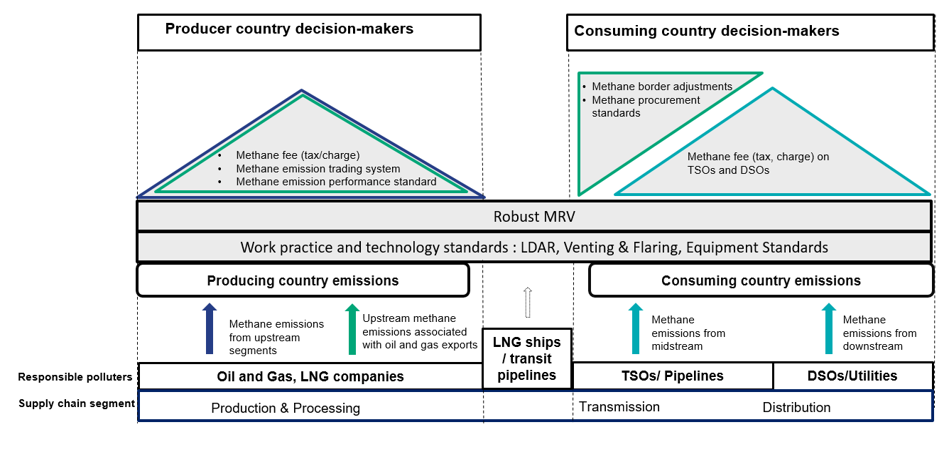This blog was coauthored by Maureen Lackner, Huong Nguyen and Aaron Wolfe.
New EDF Economics Discussion Paper describes the instrument options available to policy makers in both oil and gas producing as well as importing countries.

Measuring to assess context and quantity of methane emissions in the EU. Photographer: Jarno Verhoef.
Policy makers around the world are increasingly recognizing the need to drastically reduce methane emissions in parallel with carbon dioxide emissions. More than a hundred countries have signed the Global Methane Pledge and made a collective commitment to reduce global methane emissions by 30% by 2030 from 2020 levels.
Reducing methane emissions in the oil and gas sector is considered particularly promising, not only because of estimated low or even negative net abatement costs for many of these emission sources, but also because most of these solutions involve mature existing technologies and work practices.
What public policy instruments can help reduce methane emissions from the oil and gas sector? We address this question in our recent EDF Economics Discussion Paper Policy Instrument Options for Addressing Methane Emissions from the Oil and Gas Sector from the perspectives of oil and gas producing as well as importing countries.
The paper first describes tried and tested direct regulatory measures to address methane emissions that do not rely on emission quantification. Such regulatory instruments include mandatory and regular leak detection and repair (LDAR) and restrictions on routine venting and flaring. Technology standards implemented as requirements to install low-emitting oil and gas infrastructure equipment are also presented. Such procedures can ensure that mitigation efforts occur at every site and that emissions of local air toxins harming nearby communities (e.g., benzene) are reduced. The paper discusses how these measures have been proposed and/or implemented in various jurisdictions such as the US, the European Union, Columbia and Kazakhstan.
High standards of monitoring, reporting, and verification (MRV) of methane emissions are key to holding the industry accountable and obtaining reliable aggregate data on a country level. The paper goes on to describe the important features of a robust MRV regulation, based on the UNEP-led OGMP 2.0 framework. A robust MRV system also forms the basis for any certification schemes that wants to claim they provide credible estimates of the methane footprint of natural gas.
MRV also enables the implementation of policy instruments based on emission quantification. We make a distinction between the options available in oil and gas producing countries versus oil and gas importing countries.
For oil and gas producing countries, we describe the options of a methane emissions fee (or tax/charge); the inclusion of methane in Emission Trading Schemes (ETS) and a methane emission performance standard. All three policy instrument options include a price per unit of methane emissions and are based on emission quantification and MRV. Under these instruments, firms have more flexibility in terms of which mitigation options to use in order to comply. These instruments also have the advantage of directly providing data to track the country’s domestic emission levels over time, and even the option to design the policy instrument itself to ensure stated methane-reduction targets are met.
For oil and gas importing countries, we describe three options: regulatory equivalence i.e., a requirement that imported oil and gas be produced under equivalent regulatory standards as oil and gas produced domestically; a methane emissions procurement standard imposed on oil and gas buyers; and a methane border adjustment. The latter would need to correspond to the methane emissions price already implemented on domestic methane emissions.

Figure 1: Policy and regulatory levers for addressing methane emissions across the oil and gas supply chain. When the oil or gas comes from domestic production, the consuming country is the same as the producer country and the country’s decision-makers can regulate the whole supply chain. However, in a federal country the different segments may still be regulated by different legislative and regulatory bodies at the federal and state levels.
Regardless of which option is ultimately chosen, effective monitoring and enforcement are essential to ensure any of the policy instruments lead to actual emission reductions. For methane emissions, which is still a relatively new area for many enforcement agencies in both developed and developing countries, capacity building is also required to provide the relevant regulatory agencies with the resources and know-how to effectively monitor and enforce these regulations.
In the final section of the paper, we list outstanding research questions for public policy researchers to further analyze the potential impacts of these different policy instrument options – on methane emissions and on the oil and gas markets, as well as on end users and the related distributional impacts in different countries and regions. The opportunities to explore these research questions are quickly expanding as more methane emissions data become available, for example through UNEP’s International Methane Emissions Observatory (IMEO).
We hope this paper, which is also included in the methane policy toolkit recently published by the IEA, can help policy makers assess the instrument options available to realize the significant methane emission reduction opportunities available in the oil and gas sector.









